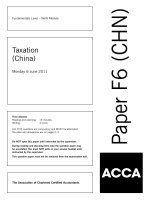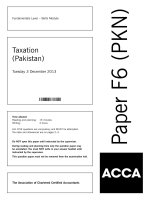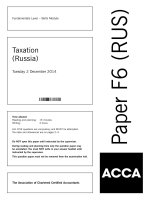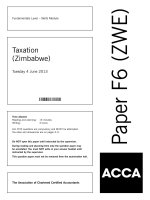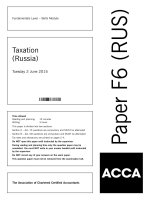ACCA f6 taxation romania 2015 dec question
Bạn đang xem bản rút gọn của tài liệu. Xem và tải ngay bản đầy đủ của tài liệu tại đây (343.51 KB, 15 trang )
Taxation
(Romania)
Thursday 10 December 2015
Time allowed
Reading and planning:
Writing:
15 minutes
3 hours
This question paper is divided into two sections:
Section A – ALL 15 questions are compulsory and MUST be attempted
Section B – ALL SIX questions are compulsory and MUST be attempted
Tax rates and allowances are on pages 2–5.
Do NOT open this question paper until instructed by the supervisor.
During reading and planning time only the question paper may
be annotated. You must NOT write in your answer booklet until
instructed by the supervisor.
Do NOT record any of your answers on the question paper.
This question paper must not be removed from the examination hall.
The Association of Chartered Certified Accountants
Paper F6 (ROM)
Fundamentals Level – Skills Module
SUPPLEMENTARY INSTRUCTIONS
1.
2.
3.
Calculations and workings should be made to the nearest lei, unless instructed otherwise.
All apportionments should be made to the nearest month, unless the law requires otherwise.
All workings should be shown in Section B.
TAX RATES AND ALLOWANCES
The following tax rates and allowances are to be used in answering the questions.
Personal income tax
General tax rate
16%
Income from employment
Benefits
Limit for non-taxable gifts
Limit for non-taxable voluntary pension contributions paid by the employer
Limit for non-taxable per diem allowance
The allowance accepted for public institutions’ employees
150 lei/person/occasion
€400/year
2·5 x public institutions’
threshold
13 lei/day/person
Deductions
Deduction allowed for voluntary pension contributions paid by the employee
€400/year
Personal deduction
Number of dependent
persons for the taxpayer
Below 1,000
Monthly gross income (MI) – lei
Between 1,000 and 3,000
Above 3,000
0 persons
250
MI – 1, 000
250 x 1 –
2, 000
0
1 person
350
MI – 1, 000
350 x 1 –
2, 000
0
2 persons
450
MI – 1, 000
450 x 1 –
2, 000
0
3 persons
550
MI – 1, 000
550 x 1 –
2, 000
0
4 persons and more
650
MI – 1, 000
650 x 1 –
2, 000
0
Note: The value of the personal deduction resulting from the calculation should be rounded up to 10 (e.g. both 212
and 217 should be rounded to 220).
Income from the sale of immovable property owned by an individual
For immovable properties sold in less than three years from their acquisition
Income
Tax rate
Up to 200,000 lei
3%
Above 200,000 lei
6,000 lei + 2% of the amount exceeding 200,000 lei
For immovable properties sold in a timeframe longer than three years from their acquisition
Income
Tax rate
Up to 200,000 lei
2%
Above 200,000 lei
4,000 lei + 1% of the amount exceeding 200,000 lei
2
Income from renting
Lump-sum deductible expenses quota
25%
Copyright income
Lump-sum deductible expenses quota for:
– monumental works of art
– other
25%
20%
Self-employed income
The limit of deductibility for protocol expenses
The limit of deductibility for compulsory subscription expenses
The limit of deductibility for subscription expenses
other than compulsory ones
The limit of deductibility for sponsorship expenses
The limit of deductibility for social expenses
Reference interest rate set by the Romanian National Bank for loans
denominated in lei
2%
5%
2%
5%
2%
3·25%
Investment income
Tax rate for capital gains from the sale of shares
Tax rate for interest received by individuals
Tax rate for dividends received by individuals
16%
16%
16%
Prize income
Tax rate for prize income
Non-taxable value
16%
600 lei/day/prize
Pension income
Non-taxable pension income
1,000 lei
Corporate income tax
General tax rate
16%
Reference interest rate set by the Romanian National Bank
for loans denominated in lei
Maximum accepted interest rate set by the Tax Code for loans
denominated in foreign currency
Inflation rate for prepayments of corporate income tax
Maximum value of deductible expenses for employees:
– voluntary pension contributions
– private healthcare insurance contributions
Maximum value of deductible expenses for subscriptions to
non-profit organisations other than those which are compulsory or due
to the chambers of commerce and to employers’ organisations
The limit of deductibility for protocol expenses
The limit of deductibility for social expenses
Maximum value of tax credit for sponsorship expenses
3
3·25% p.a.
6% p.a.
2·4% p.a.
€400/tax year/employee
€250/tax year/employee
€4,000/year
2%
2%
20% of the corporate income tax but
not more than 3‰ of sales revenue
[P.T.O.
Corporate income tax for very small companies
Tax rate
3%
Straight-line depreciation periods (for tax and accounting purposes)
Class of asset
Buildings
Machines and equipment
Computers
Cars
Period in years
50
10
3
5
Note: The straight-line depreciation method for the above periods should be used in all cases, except where a question
specifically indicates another method and/or period is to be used.
The minimum value of an asset for tax depreciation purposes is 2,500 lei.
Tax on dividends paid to legal persons
For dividends paid to legal persons resident in Romania, EU or
EFTA countries
For dividends paid to other non-residents
16% or 0%
16%
Social security and other insurance contributions
Employed persons
Social security fund
Healthcare insurance fund
Unemployment fund
Work accident fund
Health insurance indemnities fund
Fund for guaranteeing salary payments
Self-employed persons
Social security fund
Healthcare insurance fund
Unemployment fund
Work accident fund
Health insurance indemnities fund
Persons obtaining rent income
Healthcare insurance fund
Employee
10·5%
5·5%
0·5%
–
–
–
Employer
15·8%
5·2%
0·5%
0·15%–0·85%*
0·85%
0·25%
26·3%
5·5%
1%
0·15%–0·85%*
0·85%
5·5%
Persons obtaining intellectual property revenues and revenues based on Civil Code contracts
Social security fund
10·5%
Healthcare insurance fund
5·5%
Average monthly earnings
Minimum monthly salary
2,298 lei
900 lei
* The exact value will be specified in the question, where necessary.
Note: These rates should be used in answering the questions, irrespective of the time period the question refers to.
4
Value added tax (VAT)
Standard rate
Reduced rates
Annual threshold for VAT registration
Annual threshold for a monthly tax period
Annual threshold for applying the cash accounting scheme
24%
9% and 5%
220,000 lei
€100,000
2,250,000 lei
Exchange rate
Euro/lei
€1 = 4·50 lei
Note: This rate should be used in all cases except where a question specifically indicates another rate is to be used.
Interest and penalties
Interest rate for late tax payments
Penalty level for late tax payments
0·03%/day
0·02%/day
5
[P.T.O.
Section A – ALL 15 questions are compulsory and MUST be attempted
Please use the grid provided on page two of the Candidate Answer Booklet to record your answers to each multiple
choice question. Do not write out the answers to the MCQs on the lined pages of the answer booklet.
Each question is worth 2 marks.
1
A taxable person issued an invoice for a delivery which will be made after issuing the invoice. According to the legal
requirements, for this delivery the customer is liable to pay the value added tax. The invoice mentioned:
(1)
(2)
(3)
(4)
The
The
The
The
full name and address of the customer
date when the goods/services will be delivered
statement ‘reverse charge’
personal identification number of the person who issued the invoice
Which of the above items of information are mandatory for this invoice, based on VAT legislation?
A
B
C
D
2
2
1
1
3
and
and
and
and
4
2
3
4
Maria, a Romanian resident, has the following revenues in 2015:
(1) Capital gains from selling shares on the Bucharest stock exchange market
(2) An apartment, as an inheritance from a neighbour. The succession was finalised one month after the neighbour’s
death
(3) Dividends from a company based in Austria, in which she owns 50% of share capital
(4) A scholarship from the university where she studies on a masters’ degree programme
Which of the above incomes will be subject to individual income tax?
A
B
C
D
2
1
1
3
and
and
and
and
4
3
2
4
6
3
Mixer SRL, a company founded on 1 July 2014, applies the special scheme of corporate income tax for very small
companies. In Quarter 3 and Quarter 4 of 2014 and in Quarter 1 of 2015, Mixer SRL recorded the following quarterly
values (in lei/quarter) for revenues and expenses:
Revenues
– sale of goods
– exchange rate differences
– compensation from an insurance
company for damaged inventory
Expenses
– purchase of goods
– exchange rate differences
– cash-register, bought and put into
use in October 2014
Quarter 3
2014
Quarter 4
2014
Quarter 1
2015
10,000
1,000
20,000
2,500
150,000
500
2,200
15,000
2,000
10,000
1,000
80,000
300
800
What is Mixer SRL’s taxable base for corporate income tax in Quarter 4 2014 and Quarter 1 2015?
A
B
C
D
4
Quarter 4 2014
19,700 lei
21,500 lei
20,000 lei
19,200 lei
Quarter 1 2015
150,000 lei
150,200 lei
150,000 lei
152,200 lei
Sharing SA, a Romanian company founded in 2011, has the following shareholders:
Shareholder
Alpha SRL (a Romanian company)
Beta Co (a company based in the UK)
Gama Ltd (a company based in Mauritius)
Delta SRL (a Romanian company)
Five Romanian individuals
Percentage holding
15%
25%
30%
10%
20% (4% each)
Date acquired
10 October 2014
1 May 2011
13 February 2013
28 June 2012
12 June 2011
In April 2015, Sharing SA decided to distribute its entire 2014 net profit of 100,000 lei as dividends. These dividends
were paid to Sharing SA’s shareholders on 10 May 2015.
Romania and Mauritius do not have a double tax treaty. Romania and UK have a double tax treaty mentioning a 10%
withholding tax rate for dividend revenues. Beta Co has provided Sharing SA with a UK tax residence certificate for
2015 and with a statement regarding fulfilment of conditions to apply EU legislation as regards the beneficial owner
of dividends.
What is the dividend tax which Sharing SA must withhold when paying the dividends to Alpha SRL, Beta Co,
Gama Ltd and Delta SRL?
A
B
C
D
Alpha SRL
0 lei
2,400 lei
2,400 lei
0 lei
Beta Co
2,500 lei
0 lei
0 lei
2,500 lei
Gama Ltd
4,800 lei
4,800 lei
0 lei
4,800 lei
7
Delta SRL
1,600 lei
0 lei
0 lei
0 lei
[P.T.O.
5
Octavian receives the following benefits in kind from his employer:
(1)
(2)
(3)
(4)
The use of a company car for transportation from/to his home to/from his workplace
A profit sharing, according to the shareholders’ decision
Free lunch in the company’s cafeteria
Gift vouchers, on the occasion of Easter
Which of the above benefits in kind are subject to social contributions?
A
B
C
D
6
1
3
1
2
and
and
and
and
4
4
2
3
Taxatorul SRL, a Romanian company, paid the following amounts to the budget in March 2015:
(1)
(2)
(3)
(4)
Value added tax of 10,000 lei
Corporate income tax of 5,000 lei
Tax on land of 8,000 lei
Custom duties of 7,000 lei
Which of the above taxes are indirect taxes?
A
B
C
D
7
1
3
1
2
and
and
and
and
4
4
2
3
Valerie started a self-employed activity on 10 May 2015.
Which of the following statements regarding Valerie’s tax obligations in connection with her self-employed activity
are TRUE?
(1) She must submit her income tax declaration to the tax authorities each quarter, by the 25th of the last month of
the quarter
(2) She must pay her income tax quarterly, by the 25th of the last month of the quarter
(3) She must submit the declaration of estimated net income for 2015 to the tax authorities within 30 days after
starting her activity
(4) She must submit her declaration of estimated net income for 2016 to the tax authorities together with her
declaration of realised income tax for 2015
A
B
C
D
1
2
3
2
and
and
and
and
3
4
4
3
8
8
Book SRL, a company based in Bucharest, is registered for value added tax (VAT) purposes. On 20 June 2013, Book
SRL bought a laptop for 8,000 lei, exclusive of VAT, and a server for 10,000 lei, exclusive of VAT, from a VAT registered
company. Book SRL deducted the standard rate VAT charged on both items, in full, on 20 June 2013. Book SRL
decided to depreciate the laptop over three years and the server over six years, for both accounting and tax purposes.
However, on 31 December 2015 Book SRL scrapped both the laptop and the server.
What is the total amount of the value added tax (VAT) adjustment which Book SRL should make for scrapping
both the laptop and the server?
A
B
C
D
9
2,592
1,600
1,440
1,720
lei
lei
lei
lei
Andrea is employed by a company based in Bucharest. In December 2015, she receives the following revenues:
–
–
–
–
Gross salary: 5,000 lei
Non-competition allowance: 1,500 lei
Per diem allowance: 200 lei, for a two-day trip in Timisoara
Two Christmas presents of 200 lei each, for her children aged 19 and 17
What is Andrea’s gross employment revenue for December 2015, for the purpose of personal income tax?
A
B
C
D
6,735
5,385
6,885
6,950
lei
lei
lei
lei
10 Andrei is a writer, who is also employed as a teaching assistant at a university in Bucharest. In 2015 he published
two books for which he received gross revenues from intellectual property rights of 56,000 lei and 72,000 lei
respectively.
What is the difference of tax to be paid on the end of year settlement by Andrei on his intellectual property rights
revenue, if the standard treatment applies?
A
B
C
D
3,584 lei
0 lei
7,257 lei
6,144 lei
11 Leonid had the following revenues in May 2015:
(1) Rent revenue of 10,012 lei
(2) Employment revenue of 2,000 lei
(3) Revenue based on a contract concluded under the Civil Code provisions of 7,000 lei
What is the amount of the healthcare insurance contribution due for Leonid’s revenues for May 2015?
A
B
C
D
908 lei
1,046 lei
661 lei
523 lei
9
[P.T.O.
12 Stephan receives the following types of revenue in 2015:
(1)
(2)
(3)
(4)
Interest income
Rental income
Capital gains from selling shares on the stock exchange market
Self-employment income based on contracts concluded under the Civil Code
The standard tax treatment applies to all the above revenues, i.e. no option to be taxed otherwise was made by
Stephan.
From which of the above revenues should the payer withhold tax?
A
B
C
D
1
3
2
1
and
and
and
and
3
4
3
4
13 Rigla SRL pays value added tax (VAT) on a monthly basis. Its VAT due for April 2015 was 10,000 lei and for May
2015 8,000 lei. Rigla SRL made payments in respect of the VAT due for April and May 2015 as follows:
Date
19 June 2015
4 August 2015
Amount
12,000 lei
6,000 lei
What is the total amount of late payment interest and penalties Riga SRL will be charged on the overdue tax?
A
B
C
D
147 lei
98 lei
245 lei
285 lei
14 Radiera SA, a company based in Ploiesti, was founded in 2013 and has a share capital of 20,000 lei. When
computing its corporate income tax for 2013, Radiera SA deducted a legal reserve of 1,000 lei. Before computing its
final corporate income tax for 2014, Radiera SA had recorded total taxable revenues of 100,000 lei and total expenses
of 41,000 lei, including a corporate income tax expense of 4,000 lei, all other expenses being deductible.
What is the maximum amount of legal reserves which may be deducted by Radiera SA in 2014?
A
B
C
D
2,950
3,000
3,150
2,150
lei
lei
lei
lei
15 Which of the following statements regarding the computation and payment of corporate income tax are TRUE?
(1)
(2)
(3)
(4)
Without supporting documents expenses will be non-deductible for tax purposes
Dividend revenues from Romanian companies are always non-taxable
Late payment interest and penalties will be charged if the corporate income tax due is not paid every month
Transfer pricing adjustments will be made if transactions with related parties are not made at market price
A
B
C
D
1
2
1
2
and
and
and
and
3
4
4
3
(30 marks)
10
Section B – ALL SIX questions are compulsory and MUST be attempted
Please write your answers to all parts of these questions on the lined pages within the Candidate Answer Booklet.
1
(a) Tulip SRL is a company based in Bucharest, which registered for value added tax (VAT) on 1 June 2015, due to
having sales above the registration threshold. Tulip SRL only performs taxable activities and uses the quarter as
its tax period but has decided not to apply the cash accounting scheme.
On 1 June 2015 Tulip SRL held the following assets:
Type of asset
Date of purchase
Acquisition cost
(including VAT
if applicable)
as recorded in
its books at the
purchase date
(lei)
43,400
Merchandise (in
inventory)
10 January
2015
Land
20 June 2011
100,000
Apartment
10 July 2011
279,000
A car which was
new when bought
(not to be used
exclusively for
performing
economic activities)
20 September
2013
72,540
Place from which
the asset was
transported at the
time of acquisition
Status of the person
who sold Tulip SRL
the asset
From Brasov
(where the seller is
based) to
Bucharest
Not applicable –
the land is in Ilfov
county
Not applicable –
the apartment is in
Bucharest
From Hamburg,
Germany (where
the seller is based)
to Bucharest
A taxable person,
registered for VAT in
Romania
An individual,
non-taxable person
A taxable person,
registered for VAT in
Romania
A taxable person,
registered for VAT in
Germany
Required:
Calculate the value added tax (VAT) adjustment to be made by Tulip SRL on its VAT registration. (5 marks)
(b) Rose SRL, a company based in Iasi, has been registered for value added tax (VAT) since 2001. Rose SRL’s main
business consists of both taxable and exempt supplies without deduction right activities.
At the beginning of 2015, Rose SRL declared an estimated VAT pro rata of 70%. During 2015 Rose SRL had
the following transactions with Romanian taxable persons registered for VAT purposes. All values are stated
exclusive of VAT at the standard rate (where applicable).
(1)
(2)
(3)
(4)
(5)
Acquisitions relating exclusively to VAT exempt supplies: 250,000 lei.
Acquisitions relating exclusively to taxable supplies: 180,000 lei.
Acquisitions which cannot be directly allocated to taxable or exempted supplies: 220,000 lei.
Taxable supplies: 450,000 lei.
Exempt supplies: 112,500 lei.
Required:
(i)
Calculate the output value added tax (VAT), input VAT and the VAT due/to be recovered for 2015 using
the estimated pro rata.
(3 marks)
(ii) Determine the VAT adjustment to be made at the end of the year 2015, using the final pro rata.
(2 marks)
(10 marks)
11
[P.T.O.
2
Mr Cactus is employed by Forest SA, a Romanian company based in Brasov. Mr Cactus is exploring the following
options to obtain additional revenues starting from 1 April 2015.
Option 1: To become a self-employed person. Under this option, he will apply the real system for calculating the
income tax due and has calculated that his pre-payments of income tax for 2015 would be 28,000 lei and the final
income tax for 2015 would be 25,000 lei.
Option 2: To set up his own limited liability company. Mr Cactus will register the company as a taxpayer of corporate
income tax (16%) applying the pre-payments system (Note: Assume that the company would be allowed to apply
pre-payments of tax starting from the very first year of operating). Mr Cactus considers that the company’s
pre-payments of corporate income tax for 2015 will be 12,000 lei and the final corporate income tax for 2015
18,000 lei.
Option 3: To start renting out a section of his apartment. In this case the prepayments of tax for 2015 will be
5,000 lei and the final income tax for 2015 7,000 lei.
In all cases of each of the options, the pre-payments of tax will be paid on their legal due dates and any difference of
tax to be paid additionally for 2015 will be paid on 19 October 2016.
Required:
For each of the options 1 to 3 for 2015:
(a) State the tax filing obligations for 2015.
(3 marks)
(b) State the due dates for making the tax pre-payments and the due date for payment of the final tax.
(3 marks)
(c) Explain whether or not any late payment interest and penalties will be due.
(4 marks)
(10 marks)
3
Mrs Orchid is a Romanian resident. She started a small manufacturing self-employed business on 1 January 2015
and applies the real system for calculating the income tax due. The business recorded the following transactions
during 2015:
(1) Bought raw materials for 10,000 lei every month. The suppliers delivered and invoiced the goods on the fifth
day of each month and were paid by Mrs Orchid on the 15th day of each following month.
(2) Bought and paid for a car of less than 3,500 kg and less than nine seats, including the driver’s seat, costing
270,000 lei on 19 July 2015. Mrs Orchid insured the car, paying an insurance premium of 13,000 lei on
20 July 2015. On 15 December 2015, the car was involved in a small accident, after which it could still be
used immediately. On 20 December 2015, the insurance company paid Mrs Orchid a compensation claim of
10,000 lei. The car is used exclusively for business purposes, Mrs Orchid has proper documentation to verify
this.
(3) Paid total gross salaries to her employees of 40,000 lei for the year. Social contributions paid in addition to these
gross salaries were equal to 22·5% of the gross salaries. On the occasion of Easter, she offered each minor child
of her employees a present of 150 lei. Her employees have six minor children.
(4) Sold finished products for 30,000 lei each month. All these sales are paid for on the same day they are made.
(5) Made pre-payments of income tax of 16,000 lei.
Mrs Orchid’s husband, Mr Orchid, is an IT programmer who also obtains revenues as a self-employed person.
Mr Orchid applies the income quotas system and his income quota for 2015 is 97,000 lei.
Required:
Calculate the final income tax due by Mrs and Mr Orchid for the revenues obtained in 2015 and the difference
of income tax to be paid on settlement.
Note: Ignore any social contributions which may be due by Mrs and Mr Orchid on their own revenues.
(10 marks)
12
4
Daffodil SRL is a company based in Constanta, acting in the field of transport services. For 2015, Daffodil SRL’s chief
financial officer calculated the company’s initial gross profit of 900,000 lei and corporate income tax payable of
147,200 lei as follows:
Notes
Operating profit
Financial loss
Gross profit
Non-taxable revenues
Non-deductible expenses
Taxable profit
Corporate income tax at 16%
(1) and (2)
(3)
(4)
2015
(lei)
1,200,000
(300,000)
900,000
0
20,000
920,000
147,200
A subsequent tax audit by a tax consultancy firm discovered the following:
(1) Operating revenues comprised both revenues from selling services of 4,500,000 lei, and revenues from
cancelling a bad debts provision set up in previous fiscal periods of 140,000 lei. In order to minimise the tax
risk, Daffodil SRL decided since 2010 that any bad debt provision expense would be considered fully
non-deductible for tax purposes. The tax consultancy firm has confirmed that the company may use this
approach.
(2) Operating expenses included depreciation of some equipment bought on 15 October 2015 for 288,000 lei. This
equipment qualifies for the tax exemption for reinvested profits. This equipment is depreciated using the straight
line method over a period of ten years for accounting purposes and 12 years for tax purposes.
(3) The financial loss was generated from the sale of the shares owned by Daffodil SRL in Ground SA, a Romanian
company. Daffodil SRL bought 20% of Ground SA’s shares in 2012 for 500,000 lei and sold the entire
shareholding in 2015 for 200,000 lei
(4) Non-deductible expenses:
–
–
–
penalties paid to a Romanian supplier for the late settlement of debts, as per their contract, of 3,000 lei;
a fine paid to the State Budget for not filing its value added tax (VAT) return in due time of 500 lei; and
a sponsorship expense, made in accordance with the sponsorship law, of 16,500 lei.
The tax consultancy firm made no other remarks on the computation of Daffodil SRL’s corporate income tax.
Required:
Recalculate the corporate income tax payable by Daffodil SRL for 2015, according to the information discovered
by the tax consultancy firm.
Note: You should list all of the items enumerated and identify by the use of zero (0) any which do not have an
impact on the corporate income tax computation.
(10 marks)
13
[P.T.O.
5
Mr Snowdrop, a Romanian resident, is employed as a general manager by Winter SRL. His gross employment salary
is 15,000 lei/month and in addition, Winter SRL provides him with the following benefits in kind:
(1)
(2)
(3)
(4)
Voluntary health insurance for which it pays a premium of 3,500 lei/year;
Facultative private pension insurance for which it pays a premium of 5,000 lei/year;
Life insurance for which it pays a premium of 2,500 lei/year;
Liability insurance for managers for which it pays a premium of 3,000 lei/year.
All the premiums were paid in full by Winter SRL in December 2015.
Mr Snowdrop’s wife, Mrs Snowdrop, is also employed by Winter SRL. She receives gross employment income of
2,000 lei/month but does not receive any other benefits in kind. Mrs Snowdrop has two daughters in her care:
–
Miss Small Snowdrop, aged 16, is a high-school student, who receives a scholarship of 1,000 lei/month.
–
Miss Big Snowdrop, aged 21, has a degree in finance and in 2015 tried her skills on the Euronext Stock
Exchange located in Amsterdam, the Netherlands. In February 2015, she used a broker to purchase 100 shares
issued by Company 1 at a price of €10 /share; 200 shares issued by Company 2 at a price of €25 /share; and
500 shares issued by Company 3 at a price of €5 /share. In October 2015, she sold all of these shares at the
same price of €17/share. According to Dutch law, no income tax is payable by Miss Big Snowdrop in the
Netherlands on these transactions.
Required:
(a) Calculate the employment income tax due for December 2015 by Mr Snowdrop.
(7 marks)
(b) Calculate the employment income tax due for December 2015 by Mrs Snowdrop.
(3 marks)
(c) Calculate the social security fund contribution due by Winter SRL for its employees, Mr and Mrs Snowdrop,
for the month of December 2015.
Note: Assume that Mr and Mrs Snowdrop are the only employees of Winter SRL.
(2 marks)
(d) Calculate the income tax due for 2015 on the revenues received from trading in shares by Miss Big
Snowdrop.
(3 marks)
(15 marks)
14
6
(a) Daisy SRL, a company based in Bucharest, owns 90% of Leaf SRL, another company also based in Romania.
Both Daisy SRL and Leaf SRL apply standard corporate income tax (16%) and have the same tax adviser.
In 2015, before recognising into accounting any revenues/expenses for the services performed by Daisy SRL to
Leaf SRL, Daisy SRL registered a tax loss of 36,000 lei and Leaf SRL registered a taxable profit of 120,000 lei.
The tax consultant advised Daisy SRL to issue an invoice to Leaf SRL on 31 December 2015 for the services
performed of 42,000 lei. The entire amount invoiced of 42,000 lei was registered as taxable revenues by Daisy
SRL and as deductible expenses by Leaf SRL, according to the tax adviser’s opinion. The market value of the
services provided would be 5,000 lei.
Required:
(i)
Explain the basic principle applicable to transactions between related parties.
(1 mark)
(ii) Calculate the corporate income tax due by each of Daisy SRL and Leaf SRL after registering the invoice
issued by Daisy SRL into their accounting systems, according to the tax adviser’s opinion. (2 marks)
(iii) Assuming the tax administration carries out a control visit to both companies, determine whether, and
if so how much, additional corporate income tax would be established as payable by the tax inspectors.
(3 marks)
(iv) Explain, giving arguments, whether or not the tax consultant’s advice was in line with the ethical and
professional approach.
(2 marks)
(b) Petunia SRL, a company based in Bucharest, is owned 100% by Strain BV, a company based in the Netherlands.
Strain BV is not a company which specialises in the granting of loans, but on 1 January 2015 it made the
following loans to Petunia SRL:
–
–
a five-year loan of €1,000,000, bearing an interest rate of 8% per year; and
a 10-month loan of 2,000,000 lei, bearing an interest rate of 3% per year.
The market rate for similar loans is 3% for the euro denominated loan and 2·75% for the lei denominated loan.
Petunia SRL’s debt-to-equity ratio in 2015 is 2·5.
Required:
(i)
Calculate the value of Petunia SRL’s deductible and non-deductible interest rate expenses in 2015,
applying ONLY the thin capitalisation rules.
(4 marks)
(ii) Recalculate the value of Petunia SRL’s deductible and non-deductible interest expenses in 2015,
applying BOTH the thin capitalisation rules and the transfer pricing rules.
(3 marks)
(15 marks)
End of Question Paper
15
